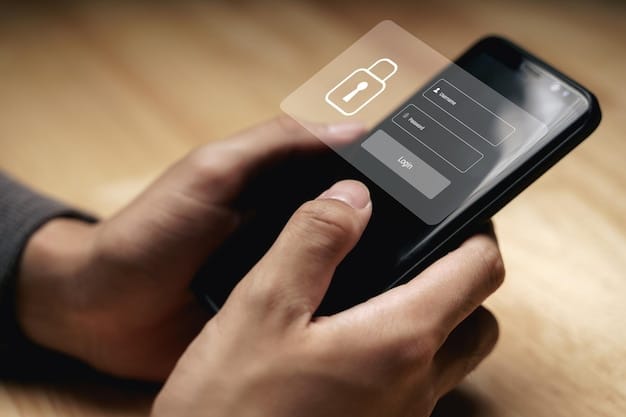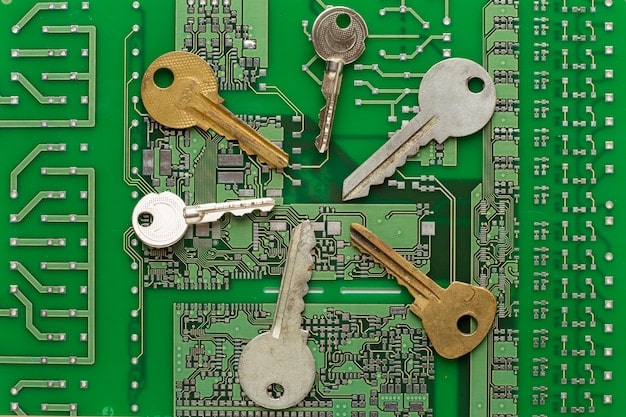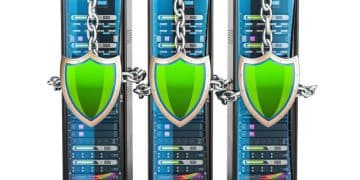Multi-Factor Authentication: Secure Your Accounts Now

Multi-Factor Authentication (MFA) is a security system that requires more than one method of authentication from independent categories of credentials to verify the user’s identity for a login or other transaction. It enhances security by adding layers of protection, making it significantly harder for unauthorized individuals to access your accounts.
In today’s digital landscape, safeguarding your online accounts is more critical than ever. One of the most effective ways to bolster your defenses is through Multi-Factor Authentication: How to Implement MFA and Prevent Unauthorized Access to Your Accounts, adding an extra layer of security beyond just a username and password.
Understanding Multi-Factor Authentication (MFA)
Multi-Factor Authentication (MFA) is a robust security measure designed to provide an additional layer of protection for your online accounts, going beyond traditional username and password combinations. It’s a critical component in preventing unauthorized access in an increasingly interconnected digital world.
The core principle of MFA is to require users to present multiple forms of identification before granting access. These factors typically fall into three categories: knowledge, possession, and inherence. Let’s delve deeper into each category to understand how they work and enhance your security.
Knowledge Factors
Knowledge factors are something only the user knows. This category traditionally includes passwords and PINs, but can also extend to security questions and answers. While passwords are the most common knowledge factor, their effectiveness is often compromised by weak or reused passwords.
Possession Factors
Possession factors are something the user has in their possession. This could be a smartphone with an authenticator app, a security token, or a smart card. Possession factors provide a stronger level of security because unauthorized individuals not only need to know your password but also possess the physical device to gain access.
Inherence Factors
Inherence factors are something the user is. This category includes biometric data such as fingerprints, facial recognition, voice recognition, and iris scans. Biometric authentication is becoming more prevalent due to its high level of security and convenience, as it is difficult to replicate or steal a person’s unique biological traits.
- Increased Security: MFA significantly reduces the risk of unauthorized access, even if your password is compromised.
- Compliance Requirements: Many industries and regulations require MFA to protect sensitive data.
- Peace of Mind: Knowing your accounts are better protected offers peace of mind in an era of constant cyber threats.
By understanding the different types of authentication factors and their respective strengths, you can implement a more secure and reliable MFA strategy to protect your online accounts and sensitive information. Embrace MFA to stay ahead of cyber threats and maintain a strong security posture.

Implementing MFA: A Step-by-Step Guide
Implementing Multi-Factor Authentication (MFA) can seem daunting at first, but with a step-by-step approach, it becomes a manageable and highly effective security measure for your online accounts. This guide provides a practical roadmap to help you through the implementation process.
The initial step involves assessing which accounts require MFA. Prioritize accounts that contain sensitive information, such as email, banking, social media, and cloud storage. Identifying these critical accounts will allow you to focus your efforts where they are most needed.
Choosing the Right MFA Method
Selecting the appropriate MFA method is crucial. Consider factors such as convenience, security, and compatibility with your devices and accounts. Common methods include authenticator apps, SMS codes, email verification, and hardware tokens. Each method has its own set of advantages and disadvantages.
Authenticator Apps
Authenticator apps generate time-based one-time passwords (TOTP) on your smartphone. These apps provide a secure and convenient way to authenticate your identity without relying on SMS codes, which can be intercepted. Popular authenticator apps include Google Authenticator, Authy, and Microsoft Authenticator.
- Set Up MFA: Enable MFA for each selected account by visiting the security settings and following the prompts.
- Install an Authenticator App: Download and install an authenticator app on your smartphone to generate unique codes.
- Configure the App: Scan the QR code or manually enter the provided key to link each account with the authenticator app.
- Test the Setup: Verify that MFA is working correctly by logging out and logging back in using the generated code.
Successfully setting up and testing MFA across your critical accounts dramatically enhances your security posture, making it far more difficult for unauthorized individuals to gain access, even if they have your password. By following these steps, you can create a strong defense against common cyber threats.
Different Types of MFA Methods
Multi-Factor Authentication (MFA) offers a range of methods to enhance your account security. Each method has distinct features, benefits, and use cases. Understanding these differences can help you choose the most suitable options for your needs.
Authenticator apps generate time-based one-time passwords (TOTP) on your smartphone. These are highly secure because they do not rely on SMS, which is vulnerable to interception. Apps like Google Authenticator, Authy, and Microsoft Authenticator are popular choices.
SMS Codes
SMS codes involve receiving a one-time password via text message. This method is widely accessible and easy to use, but it is less secure than authenticator apps due to the risk of SMS interception and SIM swapping.
Email Verification
Email verification sends a one-time password to your registered email address. This method is convenient, but it relies on the security of your email account. If your email is compromised, so is your MFA.

Hardware Tokens
Hardware tokens are physical devices that generate one-time passwords. These devices, such as YubiKeys, are highly secure because they require physical possession. They are commonly used for high-security applications and critical accounts.
- Convenience vs. Security: Balance the ease of use with the level of security provided by each method.
- Account Compatibility: Ensure the chosen method is compatible with the accounts you want to protect.
- Recovery Options: Consider backup methods in case you lose access to your primary MFA device.
Reviewing these various MFA methods and their characteristics allows you to make informed decisions about which options best fit your security needs. By carefully selecting and implementing the right methods, you can significantly strengthen your overall security posture and protect your valuable online accounts.
Benefits of Using Multi-Factor Authentication
Multi-Factor Authentication (MFA) is a critical security measure that provides numerous benefits beyond simply adding an extra layer of protection. From mitigating risks to ensuring compliance, MFA enhances your overall security posture in multiple ways.
One of the primary benefits of MFA is the significant reduction in the risk of unauthorized access. By requiring multiple forms of verification, MFA makes it substantially harder for hackers to gain access to your accounts, even if they manage to obtain your password.
Reduced Risk of Data Breaches
MFA can help prevent costly data breaches by adding a layer of security that thwarts common attack vectors. This is particularly crucial for businesses that handle sensitive customer data. Implementing MFA significantly lowers the likelihood of successful phishing attacks and credential theft.
Compliance with Regulations
Many industries and regulatory frameworks, such as HIPAA, PCI DSS, and GDPR, mandate the use of MFA to protect sensitive data. Implementing MFA helps organizations meet these compliance requirements and avoid potential penalties.
- Enhanced Security: Significantly reduces the risk of unauthorized access.
- Compliance: Meets industry and regulatory requirements for data protection.
- Increased Trust: Builds trust with customers and stakeholders by demonstrating a commitment to security.
By leveraging the benefits of MFA, you can create a more secure and compliant environment for your organization. It is an essential step in protecting your data and maintaining the trust of your stakeholders. MFA is not just a security measure; it is a strategic investment in your organization’s long-term security and success.
MFA and Mobile Devices
Mobile devices have become essential tools for both personal and professional use, making them prime targets for cyberattacks. Implementing Multi-Factor Authentication (MFA) on mobile devices is crucial to protect sensitive data and prevent unauthorized access.
Mobile devices store a wealth of personal and professional information, making them highly attractive targets for cybercriminals. Protecting these devices with MFA adds a significant layer of security, reducing the risk of data breaches and identity theft.
Securing Mobile Access
Using MFA on mobile devices helps secure access to email, cloud storage, banking, and other critical accounts. This ensures that even if a device is lost or stolen, unauthorized individuals cannot easily access sensitive information.
Mobile Device Management (MDM)
Mobile Device Management (MDM) solutions can enforce MFA on all managed devices, ensuring compliance with security policies and standards. MDM tools provide centralized control and visibility over mobile security.
- Device Security: Protects sensitive data stored on mobile devices.
- Remote Access: Secures remote access to corporate resources.
- Data Protection: Prevents unauthorized access to personal and professional accounts.
Implementing MFA on mobile devices is a critical security measure in today’s mobile-first world. By taking proactive steps to protect your devices, you can significantly reduce the risk of data breaches and safeguard your personal and professional information. MFA is a key component of a comprehensive mobile security strategy.
Best Practices for MFA Implementation
Implementing Multi-Factor Authentication (MFA) effectively requires a strategic approach and adherence to best practices. From choosing the right methods to educating users, these practices ensure that MFA provides maximum security benefits.
One of the first steps is to select MFA methods that align with your specific security needs and user preferences. Consider factors such as usability, security, and compatibility with your existing infrastructure. Offering a variety of MFA options can increase user adoption and satisfaction.
User Education and Training
Educating users about the importance of MFA and how to use it correctly is essential for successful implementation. Provide training sessions, documentation, and ongoing support to ensure users understand the benefits and potential challenges of MFA.
Regular Security Audits
Conduct regular security audits to assess the effectiveness of your MFA implementation and identify any vulnerabilities. These audits should include penetration testing and vulnerability scanning to ensure that your MFA setup is secure and up-to-date.
- Method Selection: Choose MFA methods that balance usability and security.
- User Education: Provide comprehensive training and support to users.
- Regular Audits: Conduct regular security assessments to identify vulnerabilities.
By following these best practices, you can ensure that your MFA implementation is effective, secure, and well-received by your users. This proactive approach strengthens your overall security posture and reduces the risk of unauthorized access. MFA is a vital component of a comprehensive security strategy, and its effective implementation requires ongoing attention and commitment.
| Key Point | Brief Description |
|---|---|
| 🛡️ MFA Basics | Requires multiple verification methods for account access. |
| 📱 MFA Methods | Includes authenticator apps, SMS codes, and hardware tokens. |
| 🔒 Security Benefits | Reduces unauthorized access and protects sensitive data. |
| 🏢 Compliance | Helps organizations meet industry regulations and standards. |
Frequently Asked Questions (FAQs)
▼
Multi-Factor Authentication (MFA) is a security process that requires users to provide two or more verification factors to gain access to an account or system. This significantly reduces the risk of unauthorized access.
▼
MFA is crucial because it provides an additional layer of security beyond passwords. Even if a password is compromised, unauthorized individuals still need to provide other verification factors to gain entry.
▼
Common MFA methods include authenticator apps (like Google Authenticator), SMS codes, email verification, and hardware tokens. Each method offers a different level of security and convenience.
▼
To enable MFA, navigate to the security settings of each account you want to protect. Follow the prompts to set up your preferred MFA method, such as scanning a QR code with an authenticator app.
▼
If you lose your MFA device, use the backup recovery options you set up during the MFA configuration. Typically, this involves using recovery codes or contacting customer support to regain access.
Conclusion
Implementing Multi-Factor Authentication: How to Implement MFA and Prevent Unauthorized Access to Your Accounts is a vital step in securing your digital life. By understanding the benefits and embracing best practices, you can significantly reduce the risk of unauthorized access and protect your valuable information.





